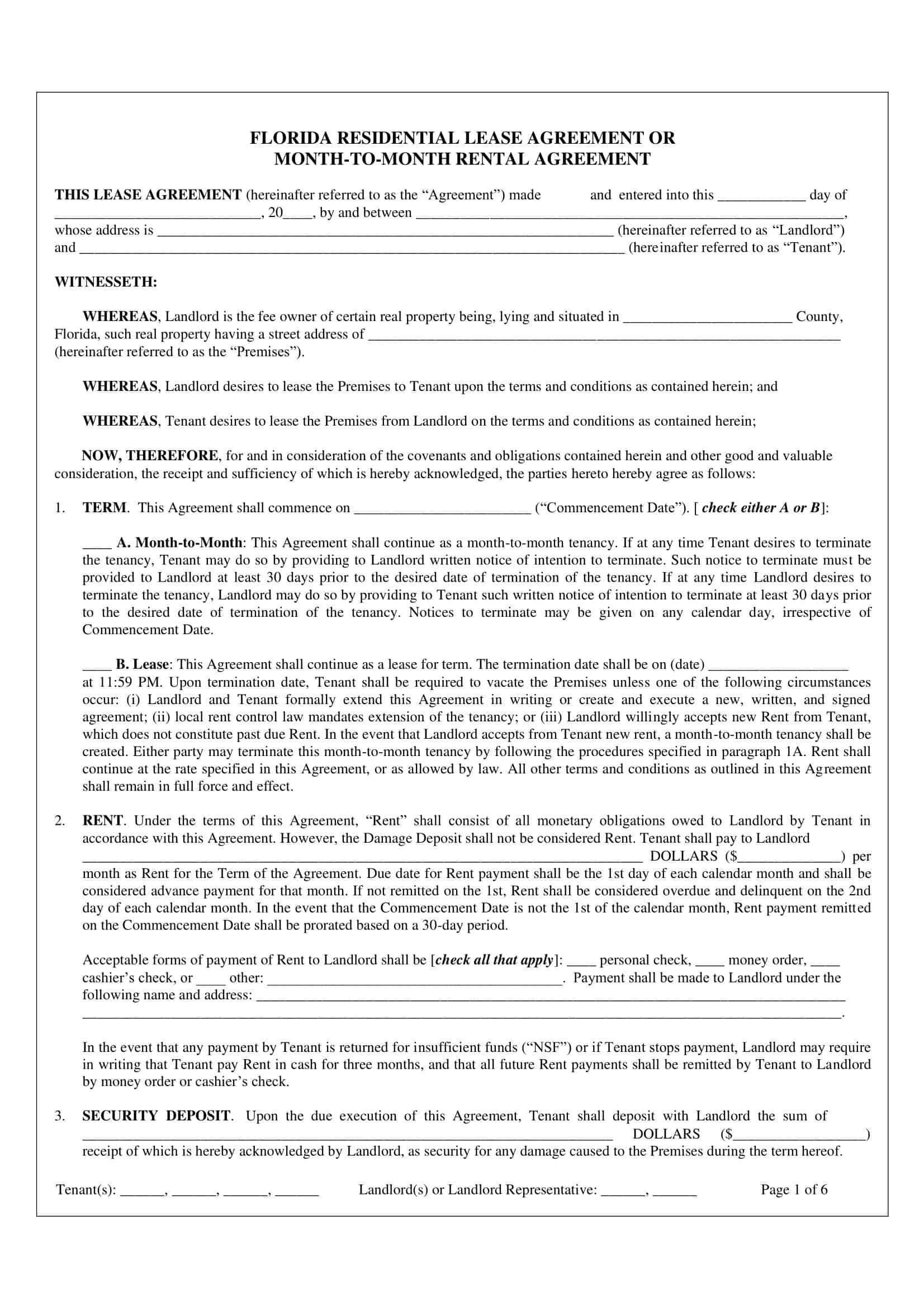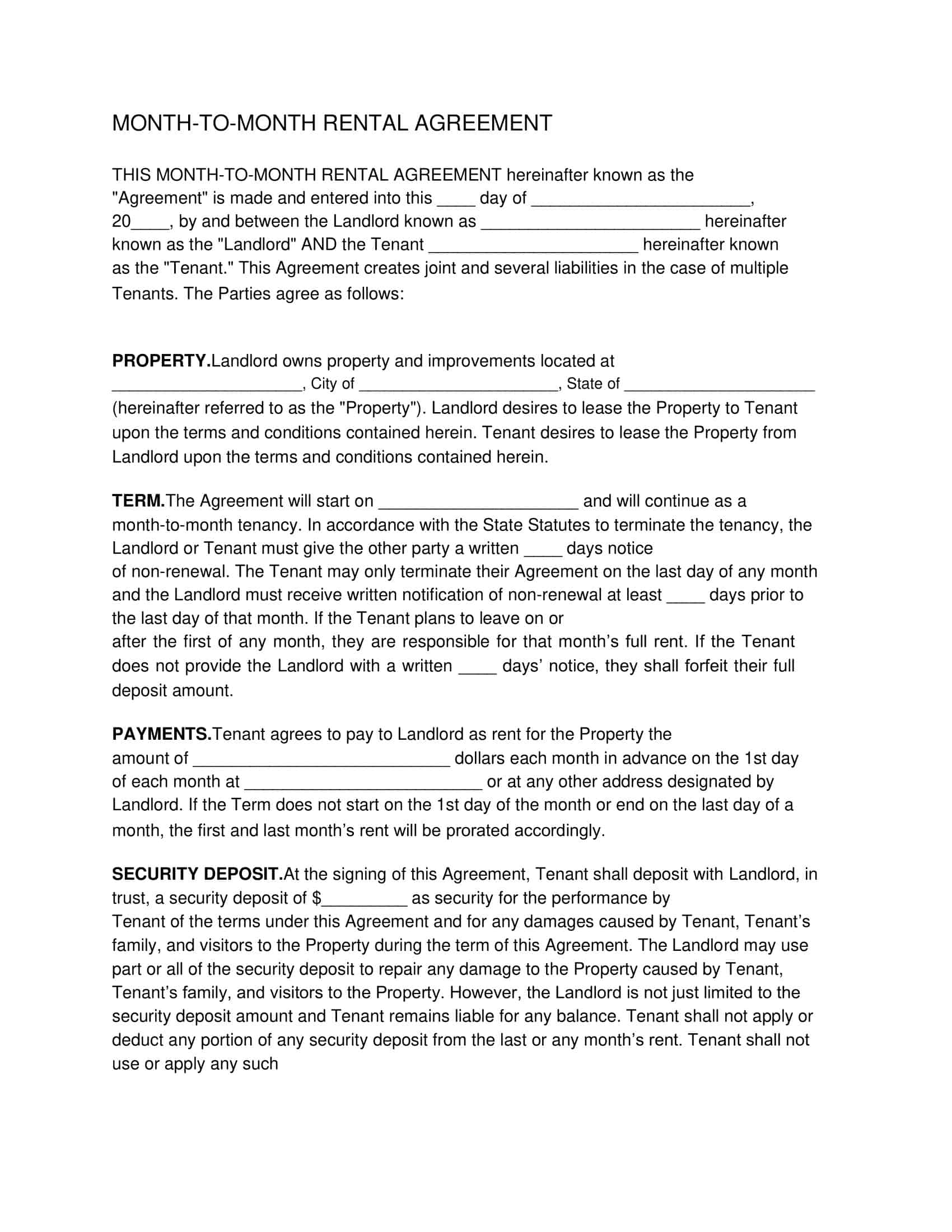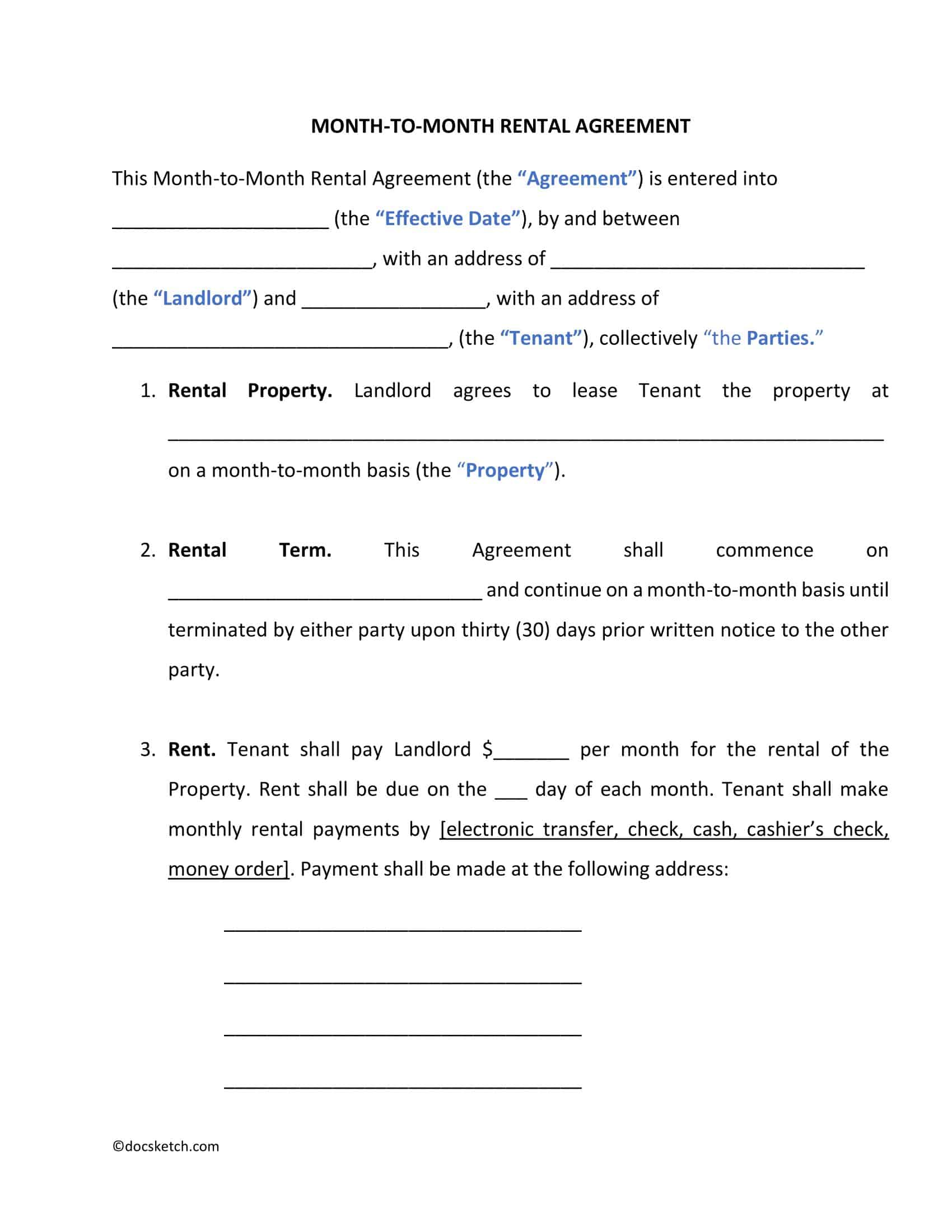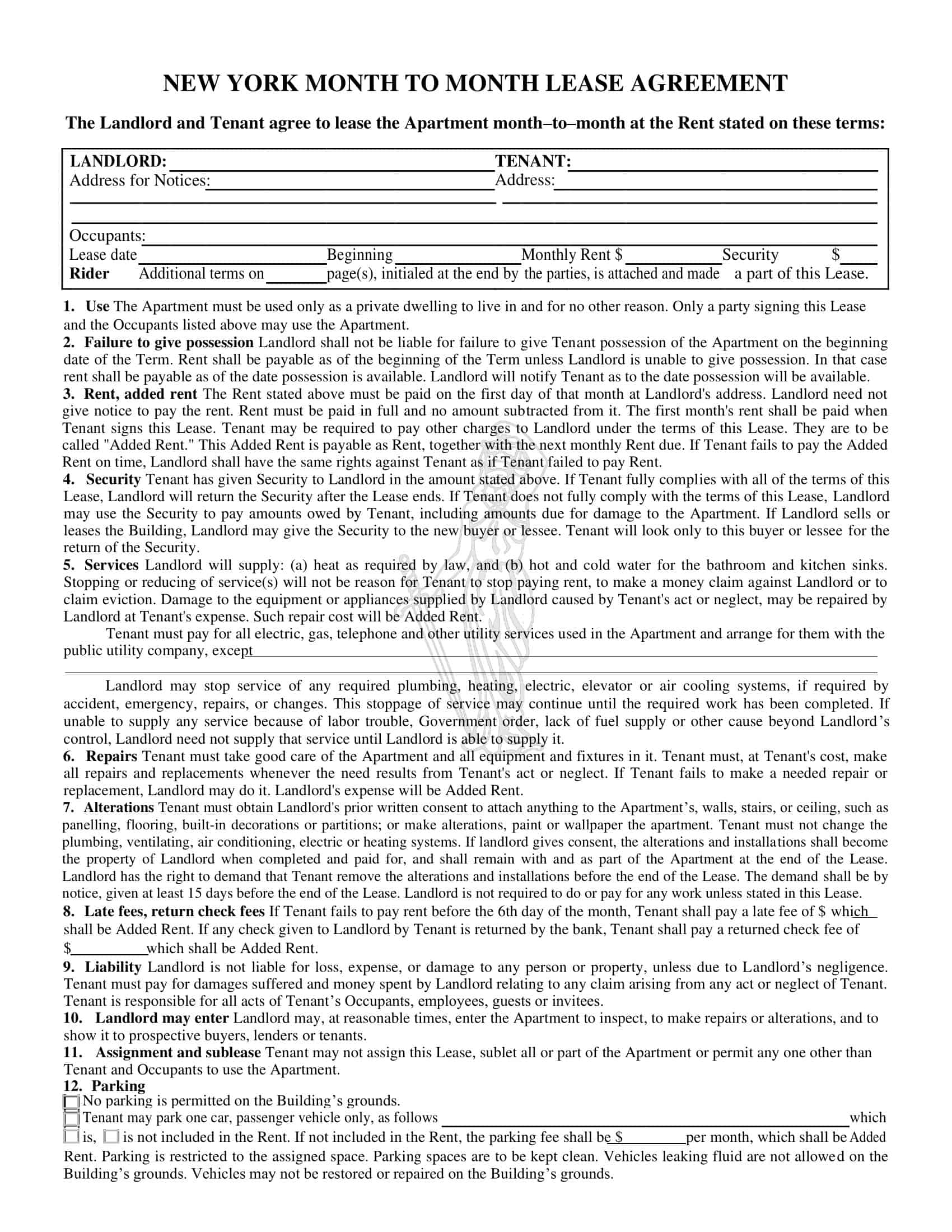Property owners encounter a variety of options to consider. A crucial factor impacting their rental enterprise is establishing the duration of the tenancy agreement. Typically, lease contracts span 12 or 18 months, but alternatives like six-month and two-year leases are not uncommon.
An alternative approach is the so-called month-to-month leasing arrangement, providing adaptability for both the property owner and renter. This type of lease comes with its own set of pros and cons. To begin, let’s delve into the fundamental aspects of a month-to-month leasing agreement.
Table of Contents
Month-to-Month Rental Agreement Templates
Simplify the process of renting or leasing residential properties with our Month-To-Month Rental Agreement Templates. Whether you’re a landlord or tenant, these printable templates provide a comprehensive framework for establishing clear and legally binding rental agreements.
Customize the templates to suit your specific rental terms, including rent amount, payment schedule, lease duration, and terms of termination. With our Month-To-Month Rental Agreement Templates, you can ensure a smooth and transparent rental process, protecting the rights and responsibilities of both parties involved. Download our free templates and create professional and reliable rental agreements that provide peace of mind for landlords and tenants alike.
What is a Month to Month Rental Agreement?

A month-to-month rental agreement, also known as a periodic tenancy or rolling lease, is a type of residential lease arrangement where the contract is renewed automatically every month, as opposed to having a fixed, long-term duration. Under this agreement, both the landlord and tenant have the flexibility to terminate the lease with a relatively short notice period, usually 30 days.
This type of leasing arrangement offers several advantages, such as increased adaptability for both parties and the possibility to adjust rent or terms more frequently. However, it also has its drawbacks, including less stability for the landlord and tenant, as well as potential fluctuations in rental income for the property owner.
Why Would You Want a Month-to-Month Lease?
A month-to-month lease can be appealing for various reasons, offering benefits to both landlords and tenants:
Flexibility: Month-to-month leases provide the flexibility to terminate or adjust the lease terms on short notice. This can be beneficial for both parties when facing uncertain circumstances or life changes, such as job relocation, family emergencies, or evolving financial situations.
Tenant screening: For landlords, a month-to-month lease allows for a trial period to assess new tenants. If a tenant proves to be problematic or does not meet expectations, the landlord can terminate the lease more easily.
Market conditions: Landlords can take advantage of changing market conditions, adjusting rent prices more frequently in response to local rental market trends. This flexibility can help maximize rental income.
Short-term housing needs: For tenants with temporary living requirements, such as students, seasonal workers, or individuals on short-term job assignments, a month-to-month lease offers an ideal housing solution without being locked into a long-term commitment.
Easier to vacate: A month-to-month lease simplifies the process of moving out for tenants, as they only need to provide a short notice period, typically 30 days, without facing penalties for breaking a long-term lease.
However, it’s essential to weigh these advantages against the potential drawbacks, such as reduced stability for both parties and the possibility of more frequent rent increases or tenant turnover.
Pros and Cons of a Month-to-Month Lease
A month-to-month lease offers various advantages and disadvantages for landlords and tenants. Here are some key pros and cons to consider:
Pros:
- Flexibility: Both landlords and tenants have the freedom to terminate or adjust the lease terms on short notice, providing adaptability in response to life changes, financial situations, or market conditions.
- Easy tenant screening: Landlords can use a month-to-month lease as a trial period to evaluate new tenants and their suitability for long-term tenancy.
- Quick rent adjustments: Landlords can capitalize on fluctuating market conditions, adjusting rent prices more frequently to maximize rental income.
- Short-term housing: Month-to-month leases cater to tenants with temporary living requirements, such as students, seasonal workers, or individuals on short-term assignments, offering them a suitable housing option without long-term commitments.
- Simplified move-out process: Tenants can easily vacate the property with a short notice period, usually 30 days, without incurring penalties for breaking a long-term lease.
Cons:
- Reduced stability: Month-to-month leases may lead to frequent tenant turnover, causing increased vacancy periods and inconsistency in rental income for landlords.
- Increased workload: Landlords might experience a higher workload due to more frequent tenant screening, lease negotiations, and property maintenance associated with tenant turnover.
- Rent fluctuations: Tenants may face more frequent rent increases, making budgeting more challenging and creating potential financial stress.
- Limited security: Tenants may feel less secure in their housing situation, knowing that the landlord can terminate the lease with short notice, potentially forcing them to find a new place to live quickly.
- Less appealing to long-term tenants: Some prospective tenants seeking stability might be hesitant to rent a property with a month-to-month lease, potentially limiting the pool of suitable tenants for landlords.
When deciding whether a month-to-month lease is the right choice, both landlords and tenants should carefully consider these pros and cons to determine if this type of arrangement aligns with their needs and preferences.
Different Types of Tenancy
Various types of tenancy agreements exist to accommodate the diverse needs of landlords and tenants. Some common types of tenancy include:
Fixed-term tenancy
A fixed-term tenancy involves a lease agreement with a predetermined duration, typically ranging from six months to several years. Both parties are bound to the terms of the lease for the entire term, offering stability and predictability.
Periodic tenancy (month-to-month)
A periodic tenancy automatically renews on a regular basis, often monthly. It offers flexibility, as either the landlord or tenant can terminate the lease with a short notice period, typically 30 days. This arrangement is suitable for those requiring short-term housing or adaptability in their living situation.
Joint tenancy
In a joint tenancy, multiple tenants share a single lease agreement and are equally responsible for the rent and adherence to the lease terms. This arrangement is common among roommates, friends, or family members living together in a rental property.
Tenancy in common
Similar to joint tenancy, tenancy in common involves multiple tenants sharing a rental property. However, each tenant has a separate lease agreement with the landlord and is individually responsible for their portion of the rent and lease terms. This arrangement is less common and can be more complex to manage.
Subletting (subleasing)
Subletting occurs when an existing tenant rents all or part of the property to another person (subtenant) for a specified period, often while the original tenant is temporarily away. The original tenant remains responsible for the lease terms and rent payments, while the subtenant pays rent to the original tenant. Subletting typically requires the landlord’s approval.
Rent-to-own (lease-option)
A rent-to-own agreement allows a tenant to rent a property with the option to purchase it at the end of the lease term or within an agreed-upon time frame. A portion of the rent paid during the lease term may be applied toward the property’s purchase price. This arrangement can be beneficial for tenants who wish to become homeowners but need time to improve their financial situation or credit.
Each type of tenancy has its unique characteristics, benefits, and drawbacks, so both landlords and tenants should carefully consider which arrangement best suits their needs and circumstances.
How to Write a Month to Month Rental Agreement
Writing a month-to-month rental agreement involves several key steps to ensure that both the landlord and tenant understand their rights and responsibilities. Here’s a step-by-step guide to help you draft a month-to-month rental agreement:
Title and Introduction:
Start by clearly indicating that the document is a “Month-to-Month Rental Agreement” at the top of the page. Provide a brief introduction that explains the purpose of the agreement and identifies the parties involved (landlord and tenant).
Property Details:
Include the full address and a description of the rental property, specifying any included appliances, furniture, or amenities.
Lease Term and Rent:
Specify the lease’s commencement date, the monthly rent amount, and the due date for payments. Include information about late fees and grace periods, if applicable.
Security Deposit:
State the amount of the security deposit required, the conditions under which it may be withheld, and the process for returning it to the tenant upon lease termination.
Maintenance and Repairs:
Clarify the responsibilities of both parties regarding property maintenance, repairs, and upkeep. Indicate which party is responsible for utilities, lawn care, and other maintenance tasks.
Rules and Regulations:
Outline any specific rules and regulations the tenant must adhere to, such as noise restrictions, smoking policies, and pet policies. If the property is part of a homeowner’s association, include relevant rules and regulations.
Notice of Termination:
Detail the required notice period for lease termination (typically 30 days) and the procedure for delivering written notice from either party.
Renewal and Rent Changes:
Explain that the lease automatically renews on a month-to-month basis, and specify the procedure for rent adjustments, including the required notice period before implementing any changes.
Landlord’s Right of Entry:
Describe the circumstances under which the landlord may enter the property, the required notice period for entry, and any exceptions in case of emergencies.
Additional Clauses:
Include any additional clauses or provisions relevant to the specific rental situation, such as clauses related to subletting, alterations to the property, or dispute resolution.
Governing Law:
Indicate the state or jurisdiction whose laws will govern the rental agreement.
Signatures and Dates:
Conclude the agreement with spaces for the landlord and tenant to sign and date the document, acknowledging their understanding and acceptance of the terms.
Before finalizing the rental agreement, both parties should review it thoroughly, seeking legal advice if necessary. Once the agreement is signed and dated, both the landlord and tenant should retain a copy for their records.
FAQs
How do I terminate a month-to-month rental agreement?
To terminate a month-to-month rental agreement, either the landlord or the tenant must provide written notice to the other party, usually 30 days before the desired termination date. The notice period may vary depending on local laws and the terms of the agreement.
Can a landlord increase rent on a month-to-month lease?
Yes, a landlord can increase the rent on a month-to-month lease. However, they must provide the tenant with written notice of the rent increase, typically 30 days in advance. Local laws and the rental agreement’s terms may dictate the specific notice period and frequency of rent increases.
Is a month-to-month rental agreement more expensive than a fixed-term lease?
Rental rates for month-to-month agreements can be higher than fixed-term leases, as landlords may charge a premium for the flexibility and increased risk associated with shorter-term arrangements. However, this is not always the case, and rental rates can vary depending on the specific property and local market conditions.
Do I need a written agreement for a month-to-month rental?
Although oral rental agreements can be legally binding, it’s highly recommended to have a written month-to-month rental agreement to clearly outline the rights and responsibilities of both parties. A written agreement can help prevent misunderstandings and provide a basis for resolving disputes.
Can a landlord evict a tenant in a month-to-month rental agreement without cause?
In most jurisdictions, a landlord can terminate a month-to-month rental agreement without cause by providing the tenant with written notice, typically 30 days in advance. However, local laws and regulations may vary, so it’s essential to familiarize yourself with the specific rules governing rental agreements in your area.
How does a month-to-month rental agreement affect security deposits?
The security deposit process for a month-to-month rental agreement is similar to that of a fixed-term lease. The landlord typically collects a security deposit at the beginning of the tenancy and returns it upon lease termination, minus any deductions for unpaid rent or property damage caused by the tenant.
Can I switch from a fixed-term lease to a month-to-month rental agreement?
Yes, it is possible to switch from a fixed-term lease to a month-to-month rental agreement. Typically, this occurs after the fixed-term lease expires, and both the landlord and tenant agree to continue the tenancy on a month-to-month basis. The terms of the new agreement should be discussed and documented in writing.
Are month-to-month rental agreements only for residential properties?
While month-to-month rental agreements are common for residential properties, they can also be used for commercial properties. However, commercial leases may have different terms, conditions, and notice periods than residential agreements.
Do month-to-month rental agreements need to be notarized?
In most cases, month-to-month rental agreements do not need to be notarized. However, it is essential to check local laws and regulations to determine if notarization is required in your jurisdiction.
Can a tenant refuse to vacate after receiving a termination notice in a month-to-month rental agreement?
If a tenant refuses to vacate the property after receiving a valid termination notice, the landlord can initiate eviction proceedings according to local laws and regulations. This process may involve filing a lawsuit, obtaining a court order, and coordinating with law enforcement to remove the tenant from the property.
Can a landlord terminate a month-to-month rental agreement without written notice?
In most jurisdictions, landlords are required to provide written notice to terminate a month-to-month rental agreement. This notice should be delivered according to the terms outlined in the rental agreement and local laws.
How do local rent control laws affect month-to-month rental agreements?
Local rent control laws can affect month-to-month rental agreements by limiting the frequency and amount of rent increases a landlord can impose. These laws may also require just cause for lease termination, even in month-to-month agreements. It’s crucial to be familiar with local rent control laws to ensure compliance.
Can a tenant make alterations to the property in a month-to-month rental agreement?
Whether a tenant can make alterations to the property in a month-to-month rental agreement depends on the terms outlined in the agreement. Most rental agreements require the tenant to obtain the landlord’s written consent before making significant alterations or improvements to the property.








































![%100 Free Hoodie Templates [Printable] +PDF 1 Hoodie Template](https://www.typecalendar.com/wp-content/uploads/2023/05/Hoodie-Template-1-150x150.jpg)
![Free Printable Food Diary Templates [Word, Excel, PDF] 2 Food Diary](https://www.typecalendar.com/wp-content/uploads/2023/05/Food-Diary-1-150x150.jpg 150w, https://www.typecalendar.com/wp-content/uploads/2023/05/Food-Diary-1-1200x1200.jpg 1200w)
![Free Printable Roommate Agreement Templates [Word, PDF] 3 Roommate Agreement](https://www.typecalendar.com/wp-content/uploads/2023/06/Roommate-Agreement-150x150.jpg)
